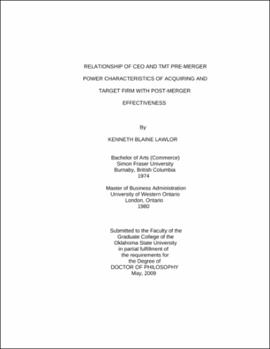| dc.contributor.advisor | White, Margaret A. | |
| dc.contributor.author | Lawlor, Kenneth Blaine | |
| dc.date.accessioned | 2013-11-26T08:20:58Z | |
| dc.date.available | 2013-11-26T08:20:58Z | |
| dc.date.issued | 2009-05 | |
| dc.identifier.uri | https://hdl.handle.net/11244/6435 | |
| dc.description.abstract | Scope and Method of Study: | |
| dc.description.abstract | Investigated the various types of power that exist within the pre-acquisition firms and how these types of power can be retained. It also examined the relationship between retained power in the post-merger firm with post-merger effectiveness and provided some empirical support on which types of power are the most important to obtain. This research also tested the moderating impact of human resource and financial slack on power retention. Archival data was captures on executives within one billion dollar mergers and regression was used to test the relationships. | |
| dc.description.abstract | Findings and Conclusions: | |
| dc.description.abstract | Support was found that an increase in the level of power in the post-acquisition firm over that which had existed in the acquiring firm resulted in a higher level of postmerger firm performance. Also it was found there were important contingencies within the power dimensions that must be analyzed to facilitate the transfer of target executive power into the post-merger firm. These contingencies included an understanding of the power levels that existed in the pre-merger firms and the impact this may have had on the retention of target executive power. Support was also found that when the acquiring organization had a higher level of prestige power than that which existed within the target organization, that target executives were more inclined to join the post-merger firm. Other important considerations were the levels of structural power within the pre merger organizations and the willingness of the CEO of the post-merger firm to share a portion of this power. The willingness of the CEO to reduce his/her level of structural power positively influenced target executive retention. Finally, financial and human resource slack was found to provide a positive impact on the transfer of power from the target organization to the post-merger firm. | |
| dc.format | application/pdf | |
| dc.language | en_US | |
| dc.rights | Copyright is held by the author who has granted the Oklahoma State University Library the non-exclusive right to share this material in its institutional repository. Contact Digital Library Services at lib-dls@okstate.edu or 405-744-9161 for the permission policy on the use, reproduction or distribution of this material. | |
| dc.title | Relationship of CEO and TMT pre-merger power characteristics of acquiring and target firm with post-merger effectiveness | |
| dc.contributor.committeeMember | Johnson, Scott G. | |
| dc.contributor.committeeMember | Frankwick, Gary Lynn | |
| dc.contributor.committeeMember | Hansen, Don R. | |
| osu.filename | Lawlor_okstate_0664D_10161 | |
| osu.accesstype | Open Access | |
| dc.type.genre | Dissertation | |
| dc.type.material | Text | |
| dc.subject.keywords | ceo | |
| dc.subject.keywords | mergers & acquisitions | |
| dc.subject.keywords | power | |
| dc.subject.keywords | prestige power | |
| dc.subject.keywords | slack | |
| dc.subject.keywords | tmt | |
| thesis.degree.discipline | Management | |
| thesis.degree.grantor | Oklahoma State University | |
